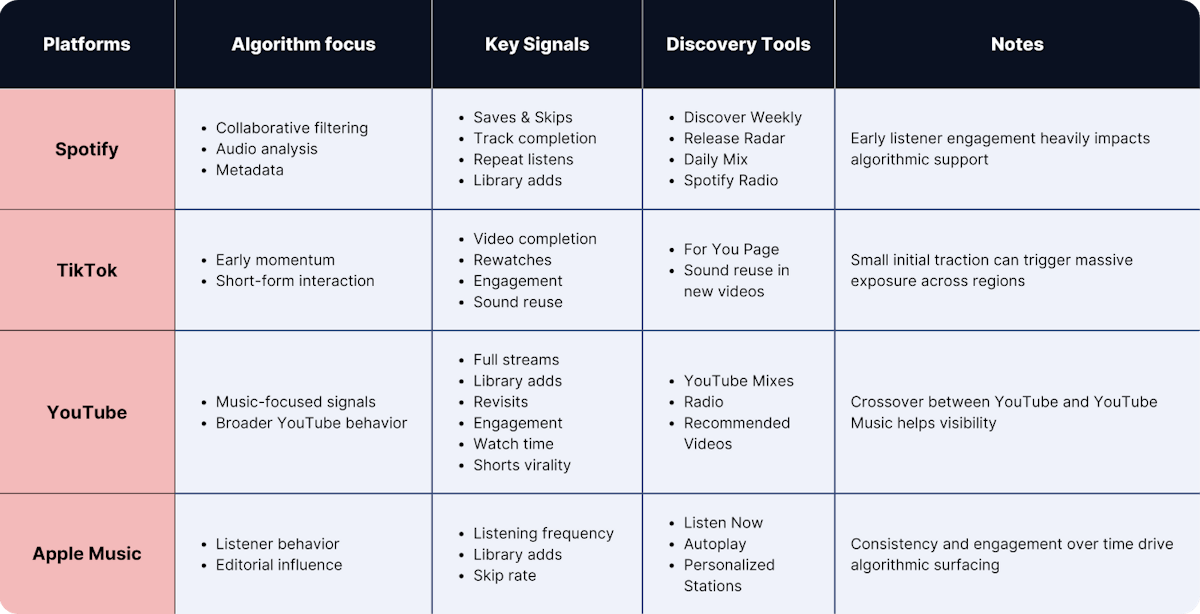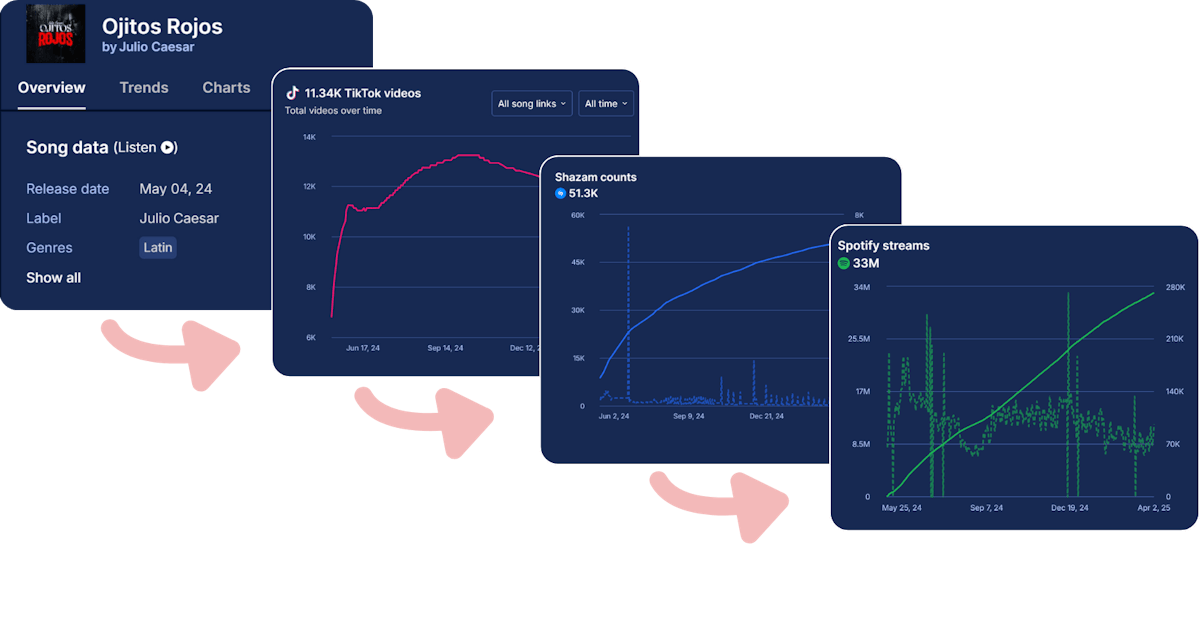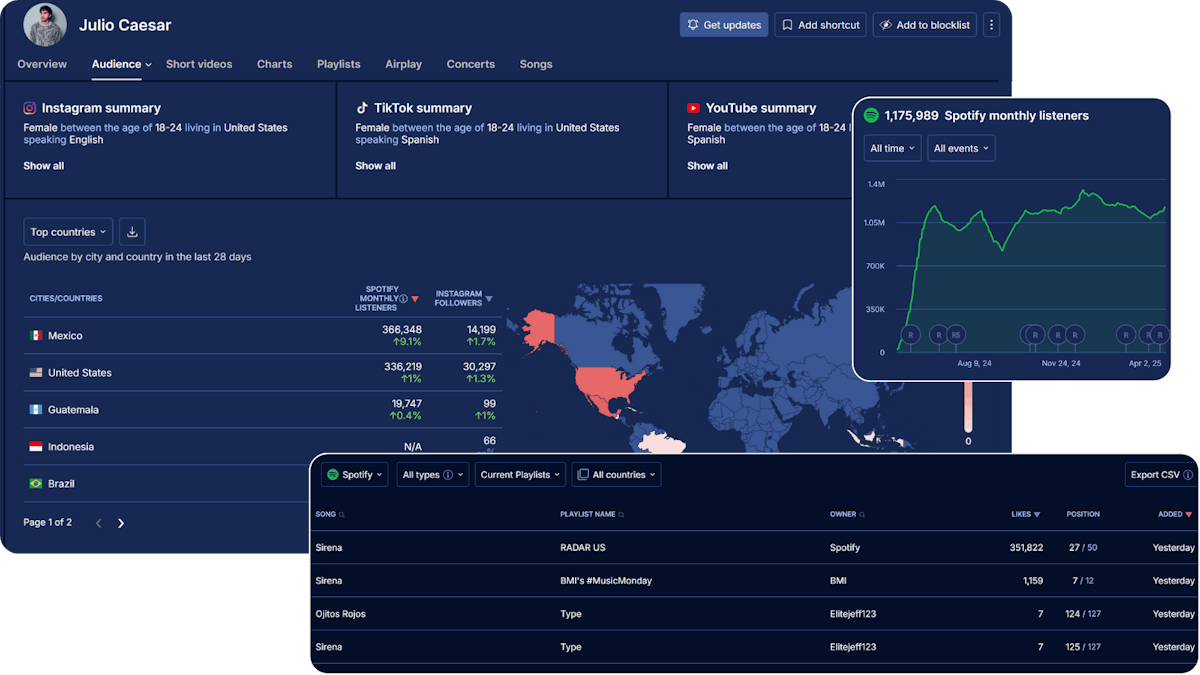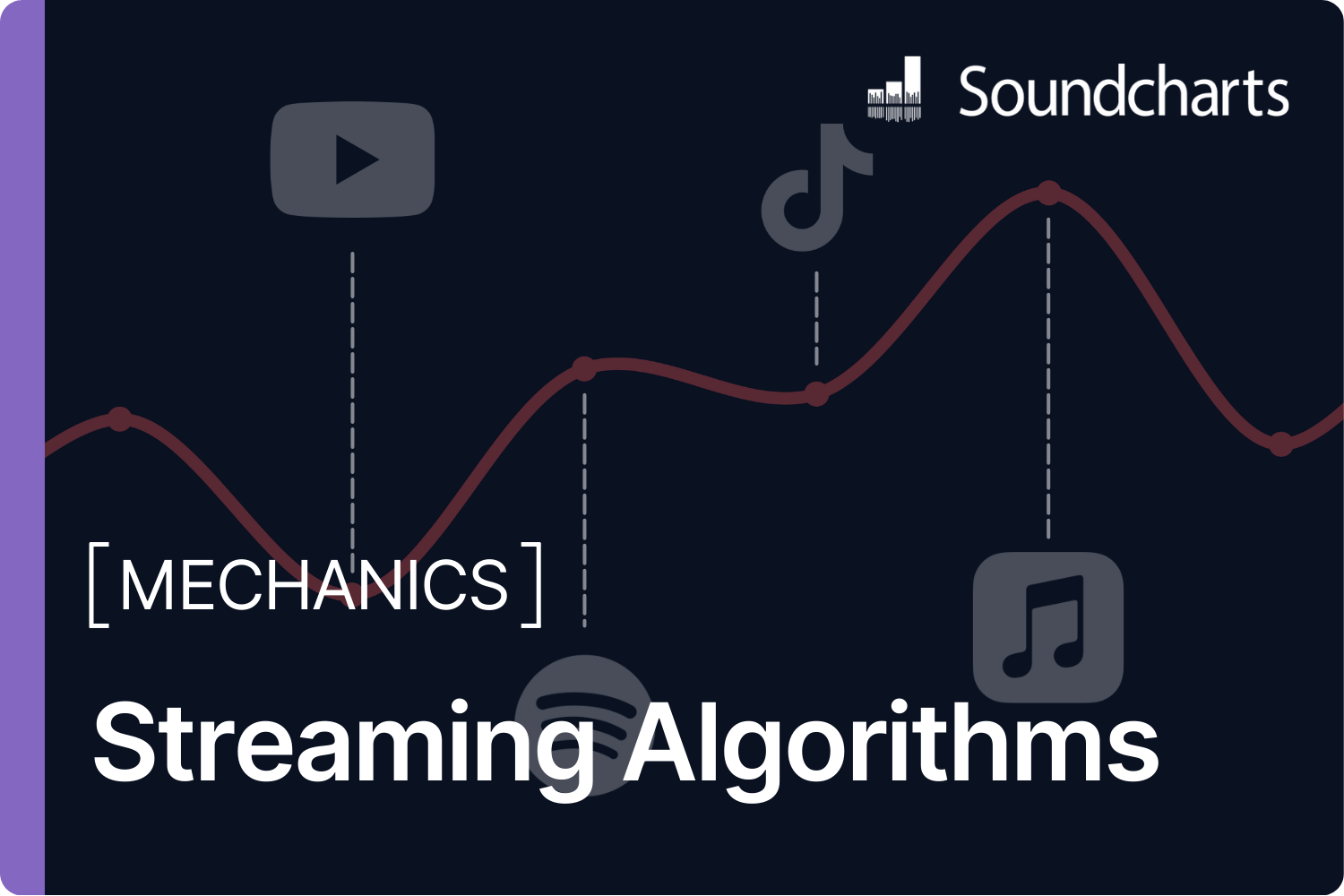Jump to
- Why Streaming Algorithms Matter for Artists
- How Music Recommendation Algorithms Work
- Spotify's Recommendation System
- TikTok
- YouTube
- Apple Music
- How to Influence Music Algorithms
- 1. Skip rate & Listening Time
- 2. Engagement & Interactions
- 3. Algorithmic & Editorial Playlists
- 4. Monitor Your Data & Adjust in Real Time
- Long-Term Strategy: Feed the Algorithm Over Time
- 1. Release consistently
- 2. Stay active between releases
- 3. Let data guide your decisions
- 4. Think beyond the algorithm
- The Real Strategy: Create, Measure, Repeat
Why Streaming Algorithms Matter for Artists
You dropped your track. You shared it everywhere. You got a few plays… then silence. Meanwhile, another artist blew up overnight — not because they had a label, but because the music recommendation algorithm picked them up.
It’s not luck. It’s data.
In 2021, a UK government study confirmed that algorithmic recommendations drive the majority of music consumption on streaming platforms. On Spotify, personalized listening sessions — including algorithmic playlists like Discover Weekly and Release Radar — account for a significant share of user engagement. In fact, Spotify has reported that around 33% of new artist discoveries happen through personalized recommendations, not direct searches or editorial placements.
And with around 100,000 new tracks uploaded to Spotify every single week (from January 1st to December 31st, 2024, we tracked 5,142,872 new releases), your chances of breaking through rely heavily on whether the algorithm decides you’re worth recommending — or not.
Every major platform — Spotify, YouTube, TikTok, Apple Music — has its own system. But they all reward the same thing: signals that show listeners are engaging with your music.
Understanding these systems doesn’t require technical expertise — just the right perspective. This guide offers a clear introduction to how recommendation algorithms work, what kind of behavior they reward, and how you can start aligning your release strategy to take advantage of them.
We’ll explore:
- How streaming and social algorithms decide what to recommend
- What metrics matter most (and how to influence them)
- How to build a long-term strategy that keeps your music visible beyond release day
How Music Recommendation Algorithms Work
Music recommendation algorithms are sophisticated systems designed to enhance user experience by suggesting tracks that align with individual preferences. These algorithms analyze vast amounts of data to predict and present music that a listener is likely to enjoy. While the overarching goal is consistent across platforms, the methodologies can vary.
Whether it’s Spotify’s Discover Weekly, TikTok’s For You Page, or YouTube’s autoplay, these systems all aim to answer the same question:
"Which track is this user most likely to enjoy — and stay with — right now?"
To generate accurate recommendations, algorithms look at three main types of data:
- Behavioral Data: This encompasses user interactions like play counts, skips, playlist additions, and search queries. For instance, a high number of plays and playlist additions signal strong user preference, influencing future recommendations.
- Content Data: Refers to the intrinsic attributes of tracks, including genre, tempo, and instrumentation. By analyzing these features, algorithms can identify songs with similar characteristics.
- Contextual Data: Involves external factors such as the user's location, time of day, and device used. For example, a user might prefer upbeat songs during workouts and calmer tracks in the evening, and the algorithm adjusts recommendations accordingly.
Engagement as a Driving Force
Across all platforms, user engagement plays a pivotal role in shaping recommendation outcomes. Active interactions, such as liking songs, creating playlists, and sharing tracks, provide algorithms with feedback on user preferences. Higher engagement levels with specific tracks or artists increase the likelihood of similar recommendations in the future.
While Spotify is the most documented platform in terms of algorithm design, each platform uses its own logic. Let’s break down the most important.

Algorithmic Discovery Features on Spotify, YouTube Music, Apple Music, and TikTok
Spotify's Recommendation System
Spotify employs a multifaceted approach to curate personalized music recommendations:
- Collaborative Filtering: This technique examines user behavior patterns to identify similarities between users. By analyzing playlists, listening habits, and user interactions, Spotify can recommend songs that are popular among users with comparable tastes.
- Content-Based Filtering: Beyond user behavior, Spotify analyzes the audio characteristics of tracks, such as tempo, key, and instrumentation. This allows the platform to recommend songs with similar sonic features to those a user has enjoyed previously.
- Natural Language Processing (NLP): Spotify scans text data from various sources, including articles, blogs, and social media, to understand the cultural context and sentiment surrounding tracks and artists. This helps in gauging the popularity and relevance of songs.
- Raw Audio Analysis: The platform's algorithms assess the raw audio files to extract features like danceability, energy, and valence. This deep audio analysis aids in creating a nuanced understanding of each track's mood and style.
By integrating these methods, Spotify crafts a comprehensive profile for each user, leading to highly personalized playlists such as Discover Weekly and Release Radar.
TikTok
TikTok’s algorithm is built for speed and scale — designed to pick up on signals of early momentum and amplify content that connects. Instead of tracking full streams or saves, it focuses on how users interact with short-form videos that use your sound.
It looks at:
- Video completion rate
- Rewatches and repeat views
- Likes, shares, and comments
- How often your sound is reused in new videos
When a track starts gaining traction — even from a small audience — the algorithm can quickly push it to new communities, regions, or even countries. That ripple effect can turn niche engagement into mass visibility almost overnight.
YouTube
YouTube Music operates within the broader YouTube ecosystem, but its algorithm is tailored to music consumption — not just video performance. It takes cues from listener behavior across both platforms to suggest tracks in radio, mixes, and personalized recommendations.
The algorithm looks at:
- How often users stream your song in full
- Whether they add it to playlists or libraries
- How frequently a track is revisited or liked
- Broader engagement across YouTube if the track has a video counterpart
Because YouTube Music is tightly integrated with the main YouTube platform, crossover signals like high watch time or viral Shorts can reinforce a track’s visibility — but music-first listening behavior is still the primary driver of recommendations.
Apple Music
Apple Music’s algorithm isn’t as transparent as Spotify’s, but it still plays a significant role in driving discovery through personalized stations, autoplay, and “Listen Now” recommendations. While editorial curation remains central to the platform, algorithmic systems respond directly to listener behavior.
It looks at:
- Listening frequency
- Playlist adds and library saves
- Skip rate
- Similar artist and track relationships
Tracks that earn consistent plays, saves, and engagement are more likely to be surfaced in algorithmic mixes — even without editorial support. Apple’s system prioritizes relevance and repetition, making it a strong discovery tool for artists who can build steady, real engagement over time.
Here’s a side-by-side comparison of key discovery mechanisms by platforms.

A comparison of algorithms from Spotify, TikTok, YouTube and Apple Music
Every platform works a little differently, but the outcome is the same: when real people connect with your music, the algorithm pays attention. Your job isn’t to outsmart it — it’s to give it something worth responding to.
How to Influence Music Algorithms
Algorithms respond to patterns — and most of those patterns start with your listeners. The more a track signals that it’s connecting with real people, the more the system is likely to push it forward.
Each platform has its own priorities, but they’re all watching the same core behaviors: do people stay with your song, do they interact with it, and do they come back for more?
If you want your music to travel further, these are the metrics that matter — and how to make them work for you.
1. Skip rate & Listening Time
Platforms: Spotify, Apple Music
Skip rate is one of the most punishing signals on streaming platforms — especially if listeners drop off within the first 30 seconds. On the flip side, high completion and replay rates increase your chances of being picked up by algorithmic features like Discover Weekly, Radio, or Autoplay.
Optimization Strategies:
- Hook listeners from the start: Open with a strong vocal line, riff, or melodic motif in the first 5–10 seconds to grab attention before listeners skip.
- Test shorter intros: If your track has a long build-up (15+ seconds), release an alternate version (e.g. a “Radio Edit”) with a tighter intro. Compare performance over time to see which version reduces skips and boosts completions.
- Get early feedback: Before going live, share the track privately with trusted listeners to gauge reactions to the opening section.
Pro tip: Tracks that show strong engagement signs within the first 48 hours — especially low skip rates and high saves — are far more likely to be picked up by Spotify's algorithmic playlists. Make your release window count by driving early traffic from loyal fans, pre-saves, and social teasers.
2. Engagement & Interactions
Platforms: TikTok, YouTube, Instagram
Short-form platforms reward content that grabs attention and drives user actions. On TikTok, the replay rate, sound reuse, and video completion are key indicators. YouTube considers watch time, likes, comments, and subscribes — especially on Shorts and music videos.
Optimization Strategies:
- Design content for loops: Create videos with satisfying or surprising endings that encourage rewatching.
- Drive participation: Launch a duet challenge, fan dance, or meme format that invites remixes with your sound.
- Use captions + storytelling: TikTok and Reels favor videos that tell a clear story visually, even on mute.
- Re-use trending formats: Apply viral templates (e.g. “day in the life,” POV, reaction cuts) to your videos featuring your tracks.
Pro tip: TikTok sounds that get picked up often result in Shazam searches and streaming platform boosts. One well-performing video can increase Spotify traffic through indirect discovery.

TikTok trends can generate Shazam counts and result in Spotify streams
3. Algorithmic & Editorial Playlists
Platforms: Spotify, Apple Music
Algorithmic playlists (like Discover Weekly, Radio, and Autoplay) are driven by listener behavior. Editorial playlists, by contrast, are manually curated — but pitching to them can boost algorithmic chances when combined with engagement.
Optimization Strategies:
- Use Spotify for Artists pitching tool: Submit at least 7 days before release with detailed metadata (mood, genre, instrumentation, target regions).
- Optimize your metadata: Accurate genre tagging helps Spotify match your track to similar editorial and algorithmic pools.
- Include call-to-actions (CTAs) in your fan communications, such as “Add this track to your chill playlist” or “Drop it into your summer mix.”
Pro tip: Editorial and algorithmic systems are interlinked. A track picked for editorial (e.g. Fresh Finds) often sees a bump in Discover Weekly two weeks later due to the engagement it generates.
4. Monitor Your Data & Adjust in Real Time
Platforms: All
Even with great planning, you won’t know what works until the data comes in. Real-time monitoring helps you react fast — boosting tracks that take off and retooling ones that lag.
Optimization Strategies:
- Track per-platform spikes: Use Soundcharts to monitor which region or platform is driving momentum — then re-target marketing spend accordingly (e.g. launch Instagram ads only in that country).
- Double down on what’s working: If a TikTok format is driving saves on Spotify, make more variations fast.
- Bundle your content: Link your music video, lyric video, and Shorts using a smart URL that encourages full-platform discovery.
- Weekly check-ins: Look at skip rate, saves, and playlist adds each Monday and adjust your rollout plan accordingly.
Pro tip: Monitor your stream-to-listener ratio to gauge audience engagement. A higher ratio indicates that listeners are replaying your tracks, signaling strong engagement.
Long-Term Strategy: Feed the Algorithm Over Time
Algorithms may reward sudden spikes, but they rely on long-term signals. To keep your music visible, you need more than just a great track — you need a strategy that feeds the system over time. That means building habits, staying present between releases, and using data to continuously adapt your approach.
In this section, we’ll break down the core components of a sustainable artist development strategy in the algorithm era.
1. Release consistently
Each time you release a track, you give platforms more data to work with — more signals to analyze and more chances to match your music with the right listeners. A consistent release cadence builds momentum, not only with your audience but within the recommendation engines themselves.
This doesn’t mean rushing out content every week. But a predictable rhythm — whether it’s monthly singles, seasonal EPs, or alternate versions of existing tracks — helps you stay top-of-mind and increases the likelihood that your name surfaces in personalized recommendations.
2. Stay active between releases
Your presence shouldn’t disappear between tracks. Artists who stay visible — even without new music — tend to perform better over time. This visibility comes from being part of the conversation, not necessarily flooding the feed.
Behind-the-scenes clips, live show moments, short-form content, fan interactions, and creative reuses of older tracks all help you stay on the radar. TikTok and YouTube Shorts, for instance, don’t care when your track came out — they care how people engage with it right now.
3. Let data guide your decisions
Every release, every post, every spike in engagement is a clue. Tracking these signals — which songs are being saved, where your audience is growing, what type of content drives plays — helps you make smarter moves.
Without data, you’re guessing. With it, you can shift your strategy in real time. Tools like Soundcharts allow artists and teams to monitor streaming, airplay, social trends, playlist placements, and more — across platforms, in one dashboard.

Track your audience, playlists placements and streams with Soundcharts
4. Think beyond the algorithm
It’s easy to focus on beating the algorithm. But long-term success comes from understanding that the algorithm is just one part of the equation. It reacts to people — and people connect with artists who show up authentically and consistently.
The more you understand your audience and how they engage, the better your chances of building real momentum. Because once you're connecting with listeners on a regular basis, the algorithm becomes less of a gatekeeper — and more of an amplifier.
The Real Strategy: Create, Measure, Repeat
The algorithm isn’t a mystery — it’s a mirror. It reflects what listeners respond to, and amplifies the tracks that spark real engagement. Success doesn’t come from chasing hacks, but from understanding how your music moves through the system — and why.
Balancing creativity with strategy is where the real challenge lies. Because if you’re not paying attention to the signals — skips, saves, shares, repeat plays — someone else will be. And they’ll be the ones getting recommended. You don’t have to game the algorithm. You just have to give it something worth noticing — and back it up with smart, informed decisions.
Ready to track your performance in real time? Discover Soundcharts →



